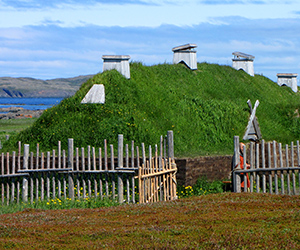CANADA HISTORY - Places-Forts
Quebec City

Quebec City holds a unique place in the history of Canada, serving as a pivotal site for numerous significant events that shaped the nation. From its founding as the heart of New France to its role in military conflicts with the English, and even as a venue for crucial wartime conferences during the Second World War, Quebec City has played a central role in Canada’s historical narrative. One of the most defining moments in its history was the 1759 Battle of the Plains of Abraham, which saw the British conquest of New France. The Quebec Citadel, a key military fortification, also played an important role in the city’s defense and continues to hold ceremonial significance as a residence of the Governor General and the home of the Royal 22nd Regiment, or the "Vandoos."
The Founding of Quebec City and New France
Quebec City was founded by Samuel de Champlain in 1608 as part of France’s colonial ambitions in North America. Situated along the banks of the St. Lawrence River, it became the capital of New France, serving as the administrative, military, and cultural hub of France’s North American territories. New France expanded as a fur trading empire, extending French influence across the continent, with Quebec City as its strategic center.
The city’s location, perched on high cliffs overlooking the St. Lawrence, gave it a natural defensive advantage. Its military importance grew over the years, with fortifications built to protect the city from potential attacks by British forces, who were keen to challenge French dominance in North America. By the 18th century, the escalating imperial rivalry between France and Britain set the stage for the most decisive conflict in the city’s history: the Seven Years’ War.
The Seven Years’ War and the Battle of the Plains of Abraham
The Seven Years’ War, which lasted from 1756 to 1763, was a global conflict between the European powers, with the North American theater known as the French and Indian War. For Britain, the war provided an opportunity to assert control over French colonial territories. British Prime Minister William Pitt developed a comprehensive strategy to dismantle France’s global empire, and a key part of that plan involved the conquest of New France.
In 1759, the British launched a major campaign to capture Quebec City, the linchpin of French control in North America. The British fleet, led by Admiral Sir Charles Saunders, sailed up the St. Lawrence River and deposited British forces under General James Wolfe on Île d'Orléans, an island strategically located across the river from Quebec City. From this position, Wolfe planned his assault on the French forces, which were commanded by General Louis-Joseph de Montcalm.
The French had fortified Quebec City with strong defenses, relying on both the natural cliffs and man-made fortifications. Throughout the summer of 1759, Wolfe launched a series of attacks on the French positions, but Montcalm and his army managed to hold the British at bay. However, in September, Wolfe executed a bold plan to land his forces on the north shore of the St. Lawrence River, scaling the cliffs at Anse-au-Foulon under the cover of darkness.
This maneuver allowed Wolfe’s army to position itself on the Plains of Abraham, just outside Quebec’s walls. Montcalm, caught off guard, decided to march his forces out of the city to meet the British in open battle. The ensuing battle on September 13, 1759, was brief but decisive. Wolfe’s disciplined forces quickly overwhelmed the French troops. Both Wolfe and Montcalm were mortally wounded in the battle, and within days, Quebec City fell to the British.
The Battle of the Plains of Abraham marked the beginning of the end for New France. Despite a French attempt to retake the city in 1760, the British held Quebec, and by the Treaty of Paris in 1763, France ceded nearly all of its North American territories to Britain. New France, as a political entity, was lost forever, and Quebec became a British colony.
The Quebec Citadel
Adjacent to the historic Plains of Abraham stands the Quebec Citadel, a military fortification that has played a key role in the city’s defense over the centuries. The origins of the Citadel date back to the early 18th century, when the French began to fortify the city against potential British attacks. The fortifications of Quebec were among the strongest in North America, and while they did not prevent the city’s fall in 1759, they were integral to the city’s defense.
Following the British conquest of Quebec, the Citadel became part of Britain’s defensive strategy in North America. As tensions with the American colonies increased in the lead-up to the American Revolution, the Citadel was further strengthened to protect Quebec from any potential attacks. Quebec was, in fact, attacked by American forces in 1775, during the early stages of the Revolutionary War. Led by General Benedict Arnold, American troops attempted to capture the city, but the British, with the help of local militias, successfully defended Quebec.
Over the years, the Citadel was rebuilt and upgraded to reflect the changing needs of military defense. Much of the current structure was constructed between 1820 and 1850, designed in the style of a star-shaped fort, which was common in European military architecture at the time. The Citadel’s elevated position on Cap Diamant gave it a commanding view of the St. Lawrence River and made it a formidable defensive position.
The Citadel’s Role in Modern Canada
In 1872, the Quebec Citadel was designated as a secondary official residence for the Governor General of Canada, alongside Rideau Hall in Ottawa. This marked the beginning of the Citadel’s ceremonial role in Canadian government, which it still fulfills today. The Citadel remains an official residence of the Governor General, and important state events and receptions are often held there.
Since 1920, the Citadel has also been the home of the Royal 22nd Regiment, known as the "Vandoos," one of Canada’s most distinguished military units. The regiment, which traces its origins to the First World War, is a French-speaking unit that has played an important role in Canada’s military history. The presence of the Vandoos at the Citadel reflects both the military heritage of Quebec and the city’s ongoing importance in Canada’s defense.
Quebec City During the Second World War
During the Second World War, Quebec City hosted two significant wartime conferences in 1943 and 1944, which were attended by the Allied leaders as they planned the final phases of the war against Nazi Germany and Imperial Japan. The First Quebec Conference, held in August 1943, brought together British Prime Minister Winston Churchill, U.S. President Franklin D. Roosevelt, and Canadian Prime Minister William Lyon Mackenzie King. They discussed strategies for the Allied invasion of Nazi-occupied Europe, which would eventually culminate in the D-Day landings in Normandy in 1944.
The Second Quebec Conference, held in September 1944, once again saw Churchill and Roosevelt meet in Quebec to discuss post-war planning and the final stages of the war. These conferences highlighted Quebec City’s symbolic importance as a secure, strategic location for crucial wartime diplomacy.
Quebec City’s historical significance cannot be overstated. From its origins as the heart of New France to its pivotal role in the British conquest during the Seven Years’ War, the city has been at the center of many of Canada’s defining moments. The Battle of the Plains of Abraham in 1759 marked the end of French colonial rule in North America, and the Citadel of Quebec has stood as a symbol of military strength and colonial legacy ever since. Today, Quebec City is a vibrant part of Canada’s heritage, serving as both a living reminder of the past and a modern symbol of Canadian culture and identity. Its role in global history, from the Seven Years’ War to the Second World War, cements its place as one of Canada’s most historically significant cities.
Cite Article : Reference: www.canadahistory.com/sections/documents/documents.html
Source: NA



